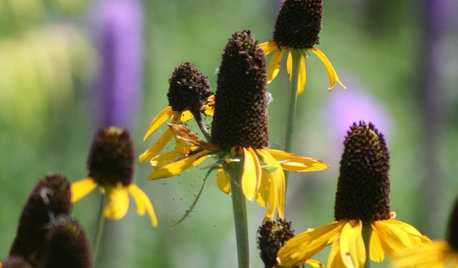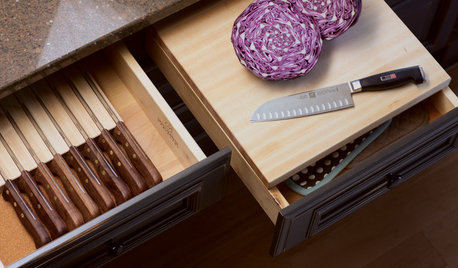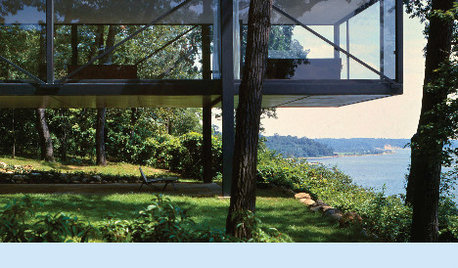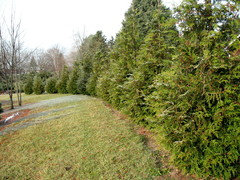Need advice for Green Giant planting on Long Island.
Kevin
8 years ago
Featured Answer
Sort by:Oldest
Comments (48)
Related Discussions
Watering newly planted Thuja Green Giant
Comments (18)scotjute: Sorry to take so long to get back but I was waiting for an email notification. The TGG has been in the ground for 3 weeks and seems to be holding it's own. It was trucked in from Oklahoma and took 4 days by UPS. It has a 3/4 inch trunk but there are 2 other 1/4 inch stems coming up from the root ball. Using the soaker hose it gets 18 gallons (2 hours) about every 3-4 days. The temp now runs about 98-104F and the last meaningful rain is a distant memory. (6-8 weeks.) We get most of our rain in July and August during the Monsoon season. About 1/3 of the leaf tips have a yellow tinge to them but like motownnj above I don't know if it's stress or something else. In your opinion, am I giving it too much water? I only soak it when the cheapo moisture meter, my finger and the wooden dowel think it's time. There is 3 inches of Composted Mulch on top which in this climate dries out quickly!...See MoreNeed advice on whether I can plant a lot of green giant Arborvitae
Comments (7)Thanks for the input. Here are some more pics. The first to show the chain-link fence and what I'm trying to screen from. The second to show the other side of the property where I have a Woodfence that I want to add privacy trees in front of. You can also see that it's downward sloped and it gets a little wet. I checked out the juniper they do seem to be a little pricey. Since my place is fenced in would you suggest emerald green instead?...See MoreHelp caring for my green giant shrubs! Advice needed
Comments (5)Amber, don't worry at all about pruning these things for a while. Better to let them be for now. Later, if they need any attention at all, it will be to attempt to have them maintain a single leader, and then to remove any broken branch that may happen. Other than that, good to go just as they are....or will be, I should say....See MoreCamellias in Long Island - advice needed
Comments (4)The short answer is one plant and a bigger bed. Some camellias like to spread, others get bushy, some are kind of columnar, etc. You have to review their described growth habit to see if they will "work" for you (this info is shown in the plant labels or in the plant description in Internet pages). I have not seen those two but I quickly noticed that they get large. If you are trying to confine them to that bed, consider... Korean Fire for example: height 10-15'; spread 5-8' per the Missouri Botanical Gardens. Long Island Pink: height 10', wide 8' per Monrovia. Since that last one was found in LI, it would be the one I would choose if those were the only two choices. My concern is winter hardiness. Most of LI is Zone 7 but it may be best for you to choose plants that can handle cold of a zone colder (Zone 6) because you probably do get some winters that are unusually cold. That is where I ran into another concern. When I checked those two camellias on the Internet, some places said they were winter hardy to Zone 6 and others said winter hardy only to Zone 7. That makes it hard to recommend those but, like I said, if the choice was limited to only those two, then I would choose the LI Pink since it was found in a hedge of camellias growing in LI back in the 70s. I would recommend early blooming sasanquas rated for Zone 6b (like some of the Autumn Series) or late blooming Japonica Camellias rated for Zone 6b (like some of the April Series). Contact Camellia Forest Nursery (www.camforest.com) for specific recommendations. April Melody is described in their website as compact and erect but I could not see estimated plant dimensions in their website, which is why I suggest calling them and asking for suggestions: http://www.camforest.com/Camellia_japonica_April_Melody_p/c-apmel2qt.htm Other mail order sources: https://www.americancamellias.com/about-american-camellia-society/acs-member-nurseries/retail-nursuries Then again, while thinking further, I went back to the fact that LI Pink is a sasanqua and that means it develops flower buds and blooms early (sometime in the Fall). This is important because the fate of sasanqua flower buds are not subject to the vagaries of winter weather: it would be extremely rare that cold weather would make the plant abort the sasanqua flower buds or kill sasanqua blooms. However, the above mentioned late-blooming Japonicas may have this problem in very cold weather. Or when winter temps get high, stay high for several days, and then come crashing down. So, look too at some of the Autumn Series that are compact and winter hardy such Autumn Spirit (5-6' height/width). And then there is also the fall-blooming Winter Series, by the US National Arboretum and developed by Dr. William Ackerman: http://www.usna.usda.gov/Newintro/camelli1.html Just look for compact ones that will fit in your bed....See MoreKevin
8 years agoEmbothrium
8 years agoKevin
8 years agolast modified: 8 years agoEmbothrium
8 years agoKevin
8 years agolast modified: 8 years agoKevin
8 years agoMike McGarvey
8 years agoEmbothrium
8 years agolast modified: 8 years agoMike McGarvey
8 years agoKevin
8 years agoken_adrian Adrian MI cold Z5
8 years agoEmbothrium
8 years agolast modified: 8 years agoKevin
8 years agoKevin
8 years agolast modified: 8 years agoKevin
8 years agolast modified: 8 years agoKevin
8 years agolast modified: 8 years agoKevin
8 years agoEmbothrium
8 years agoKevin
8 years agodavidrt28 (zone 7)
8 years agolast modified: 8 years agodavidrt28 (zone 7)
8 years agolast modified: 8 years agoKevin
8 years agolast modified: 8 years agoKevin
8 years agoKevin
8 years agolast modified: 8 years agoKevin
7 years agoken_adrian Adrian MI cold Z5
7 years agoKevin
7 years agoKevin
4 years agolast modified: 4 years agodavidrt28 (zone 7)
4 years agoKevin
4 years agoKevin
4 years agolast modified: 4 years agoplantkiller_il_5
4 years agoalley_cat_gw_7b
4 years agoKevin
4 years agodavidrt28 (zone 7)
4 years agoKevin
4 years ago56steps
4 years agoKevin
4 years agoken_adrian Adrian MI cold Z5
4 years agoKevin
4 years agolast modified: 4 years ago
Related Stories

GARDENING FOR BUTTERFLIESGreat Design Plant: Giant Coneflower, a True Exclamation Point
Watch as towering stalks topped by yellow blossoms become a beacon for birds and insects in the midsummer garden
Full Story
DECORATING GUIDES10 Design Tips Learned From the Worst Advice Ever
If these Houzzers’ tales don’t bolster the courage of your design convictions, nothing will
Full Story
FARM YOUR YARDAdvice on Canyon Farming From L.A.'s Vegetable Whisperer
See how a screened garden house and raised beds help an edible garden in a Los Angeles canyon thrive
Full Story
LIFEEdit Your Photo Collection and Display It Best — a Designer's Advice
Learn why formal shots may make better album fodder, unexpected display spaces are sometimes spot-on and much more
Full Story
KITCHEN DESIGNSmart Investments in Kitchen Cabinetry — a Realtor's Advice
Get expert info on what cabinet features are worth the money, for both you and potential buyers of your home
Full Story
KITCHEN STORAGEKnife Shopping and Storage: Advice From a Kitchen Pro
Get your kitchen holiday ready by choosing the right knives and storing them safely and efficiently
Full Story
HEALTHY HOMEHow to Childproof Your Home: Expert Advice
Safety strategies, Part 1: Get the lowdown from the pros on which areas of the home need locks, lids, gates and more
Full Story
LIFEGet the Family to Pitch In: A Mom’s Advice on Chores
Foster teamwork and a sense of ownership about housekeeping to lighten your load and even boost togetherness
Full Story
REMODELING GUIDESContractor Tips: Advice for Laundry Room Design
Thinking ahead when installing or moving a washer and dryer can prevent frustration and damage down the road
Full Story
BOOKSBook to Know: 'Long Island Modernism 1930-1980'
Photographs mix with social history from the architectural highlights of Long Island's suburbanization
Full Story











ken_adrian Adrian MI cold Z5